Japan's Official Development Assistance White Paper 2012
(2) Health, Welfare, and Population
A large number of people living in developing countries do not have access to the basic health services that are usually available in developed countries. Additionally, the lack of immunization systems and hygienic environments has led to the annual loss of 6.9 million children under the age of five due to infectious diseases, malnutrition, diarrhea, and other health ailments.(Note 4) Moreover, over 280,000 pregnant women lose their lives every year without getting emergency obstetric care by skilled birth attendants like midwives. (Note 5)
Meanwhile, the world’s population continues to increase, and according to "World Population Prospects: The 2010 Revision," the world population exceeded 7 billion on October 31, 2011, and was expected to reach 9.3 billion in 2050. In general, the rate of population growth is higher for especially poorer countries that lead to further poverty, unemployment, food shortages, delayed education, and environmental deterioration.
From the perspective of solving these problems it is a pressing challenge to take measures addressing maternal and child health, reproductive health including family planning and HIV/AIDS, which can have an enormous impact on population issues.
It is also estimated that with population increases, there are more than 1 billion people living with some form of disability due to increasingly aging populations and their chronic ill health.(Note 6) Many of these people live in the developing regions, where they are outcast from socio-economic opportunities such as education and employment, driving them further into poverty. Poverty reduction is key to providing people with disabilities with opportunities for social participation and independence.
<Japan’s Efforts>
●Health and Medicine
Over the past years, Japan has attached great importance to global health, as one of the global challenges, which is directly related to human security. Japan has led international discussions on health system* strengthening. Specifically, at the G8 Kyushu-Okinawa Summit in 2000, infectious diseases were taken up for the first time as a major item on the agenda of the Summit. This led to the establishment of new funding mechanisms such as the "Global Fund to Fight AIDS, Tuberculosis and Malaria" in 2002.
In 2005, Japan has started working on the "Health and Development Initiative", which aims to help achieve the health-related MDGs: Goal 4: reducing child mortality, Goal 5: improving maternal health, Goal 6: preventing the spread of HIV/AIDS, malaria, and other infectious diseases. Further, at the July 2008 G8 Hokkaido Toyako Summit, the "Toyako Framework for Action on Global Health" was released under agreement by the G8 nations, asserting the importance of strengthening health systems. Moreover, at the G8 Muskoka Summit (Canada) in June 2010, under the Muskoka Initiative Japan announced that it would additionally provide, up to ¥50 billion, approximately $500 million (as of June 2010), over next five years from 2011 in the field of maternal and child health which are the most off-track of all the MDGs.
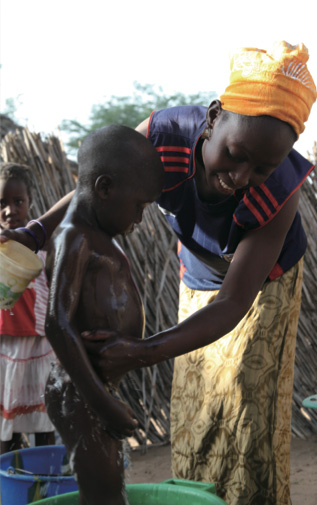
A mother washes the body of a child in rural Senegal (Photo: Seico Tamai)
In addition, Japan presented the "Japan’s Global Health Policy 2011-2015" at the September 2010 UN Summit on the MDGs, and announced that Japan would provide $5 billion of aid (including a contribution of up to $800 million to the Global Fund to Fight AIDS, Tuberculosis and Malaria (the Global Fund) in the coming years from 2011), for the purpose of contributing to the achievement of the health-related MDGs. The three pillars of Japan's global health policy are; (i) maternal newborn and child health; (ii) measures against the three major infectious diseases*(HIV/AIDS, tuberculosis, and malaria); and (iii) response to public health emergencies, including polio and new strains of pandemic influenza. Japan is striving to provide assistance based on the "EMBRACE model"* particularly for maternal and newborn child health, which are the most off-track to meet the targets. Under this new policy, Japan has formulated a strategy for implementation of efficient support in Ghana, Senegal, Bangladesh, and other countries. This strategy encourages mutually complementary collaboration with international organizations and other development partners, and sets Japan's sights to provide support to enable partner countries to tackle issues and achieve the health-related MDGs. Moreover, Japan aims to work with international organizations and other development partners to save approximately 430,000 maternal lives and 11.3 million children's lives across partner countries. In particular, by strengthening measures against HIV/AIDS, tuberculosis and malaria in making further financial contributions to the Global Fund and Japan's bilateral assistance, Japan is working to provide effective assistance to reduce 470,000 deaths by AIDS, 990,000 deaths by tuberculosis, and 3.3 million deaths by malaria across partner countries, in cooperation with other development partners. As a continuation of the 2010 MDG Summit, the MDG Follow-up Meeting was held in Japan in June 2011. At the Meeting, the breakout session for health debated policies (health systems and non-infectious diseases such as cancer and diabetes) that focus on health-related MDGs and development goals beyond 2015 (post-2015 development agenda) and also published a summary of the results.
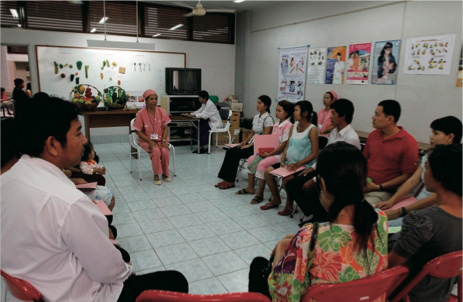
Pregnant women learning about health at Cambodia's National Maternal and Child Health Center (Photo: Satoshi Takahashi/JICA)
- *Health System
- Health system includes mechanisms for the preparation and maintenance of government systems, the improvement of healthcare facilities, the optimization of the supply of pharmaceuticals, the accurate understanding and effective utilization of healthcare information, financial administration, and the acquisition of financial resources, as well as the development and management of personnel to operate these processes and provide services.
- *The three major infectious diseases
- Refers to HIV/AIDS, tuberculosis, and malaria. Worldwide deaths from these diseases total to approximately 3.5 million each year. The spread of these infectious diseases significantly impacts society and the economy, and is a factor that inhibits national development. Accordingly, it is a serious threat to human security, and a global issue that must be addressed by unified efforts of the international community.
- *EMBRACE Model (Ensure Mothers and Babies Regular Access to Care)
- Assistance model for pregnant women to ensure a continuum of care, covering both prenatal and postnatal periods. This includes regular checkups for pregnant women, treatment for newborns at hospitals equipped with the appropriate equipment and personnel, improvement of access to hospitals, and vaccinations.
Note 4: Source: UNICEF, WHO, the World Bank and the UN "Levels and Trends in Child Mortality - Report 2012"
Note 5: Source: WHO, UNICEF, UNFPA, and the World Bank "Trends in Maternal Mortality : 1990 to 2010"
Note 6: Source: WHO "WORLD REPORT ON DISABILITY" http://www. who.int/disabilities/world_report/2011/en/index.html![]()
![]()
●Bangladesh
(1) Safe Motherhood Promotion Project
Technical Cooperation Project (July 2006 - June 2011/July 2011 - Present)
(2) Project for Improving Maternal and Child Health Care (Phase 1) ODA Loan (January 2012 - Present)
The maternal mortality rate in Bangladesh is high. Contributing factors include a low rate of expecting and nursing mothers who seek medical consultation, the rarity of appropriate action being taken when signs of danger occur during pregnancy, and a low number of births being attended by caregivers with midwifery skills. For these reasons, Japan joined up with JOCV in 2006 in an effort to improve the health of expecting and nursing mothers and newborn babies through the Safe Motherhood Promotion Project. In addition to assisting with the creation of a locally mobilized maternal support system and improvements in regional healthcare facilities and services, Japan has been assisting local governments to ensure that administration is in line with regional needs. The Narsingdi Model*, named after the district being assisted, has been used to construct a system of cooperation between local communities, medical facilities, and the government. While expecting and nursing mothers and newborn babies being cared for effectively, the number of expecting and nursing mothers receiving maternity checkups and giving birth at public facilities has risen substantially, and usage rates for emergency obstetric care have increased significantly in the target districts.
The Bangladesh government has praised these efforts and adopted them into the new five-year strategic plan for the healthcare sector (Health, Population and Nutrition Sector Development Program) started in 2011. Aiming to improve the maternal and child health situation throughout Bangladesh, Japan provides necessary funds in the form of ODA loans to train local government officials and medical personnel, install equipment for clinics, hospitals and other facilities, and provide assistance to the Bangladesh government and its nationwide efforts.
(As of December 2012)
*Narsingdi Model: 1) Establish a locally mobilized maternal support system in communities that is prepared for child delivery and the related emergencies that can occur, 2) Improve quality of services at public medical institutions, 3) Establish a system for the local administration to regulate services offered by medical institutions based on community needs
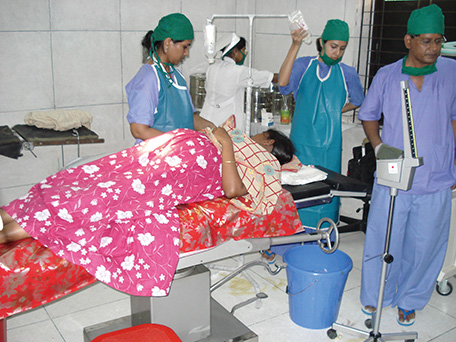
Hospital staffs are trained to provide emergency obstetric care. (Photo: JICA)
●Palestine
Project for Improving Maternal and Child Health / Reproductive Health in Palestine (Phase 2)
Technical Cooperation Project (November 2008 - November 2012)
The Palestinian Interim Self-Government Authority was established for the Palestinian territories based on the Oslo Accords of September 1993. However, Israel's continued practice of the occupation policies of economic blockade, settlement activities, separation barrier and checkpoints, and curfews has restricted movement of the people and goods and greatly impacted the lives of the people. In the field of maternal and child health in particular, there are hospitals and clinics that have been run by UN agencies and NGOs before the establishment of Palestinian Authority in addition to the hospitals and clinics run by the Ministry of Health of the Palestinian Authority. Under the circumstance of movement restrictions and economic situations, many women are forced to visit multiple institutions in order to obtain child vaccinations and prenatal, childbirth, or postpartum care depending on the conditions they face at each time.
To help improve Palestine's unique circumstances, Japan started introducing Japanese maternal and child health handbooks (MCH handbooks) throughout the Palestinian territories in 2005, while providing assistance to improve the abilities of the local doctors and nurses who use them. Cooperating with the Ministry of Health, UN agencies, and NGOs, Japan began full-scale distribution of MCH handbooks in the West Bank in 2008 and the Gaza Strip in 2009. As of 2010, 90% of women in the West Bank had received MCH handbooks, while in the Gaza Strip, where Japanese specialists are unable to work directly due to safety reasons, 60% of women had received them. Additionally, with the help of the United Nations Relief and Works Agency for Palestine Refugees in the Near East (UNRWA), Japan has been able to expand these activities to include mother and child refugees living in Jordan and Syria. MCH handbooks recording pregnancy, childbirth, and postpartum health in addition to hospital history and a record of the child's growth allow women to receive appropriate medical care at any of the region's clinics. Additionally, they are highly valued by users, because they are able to provide parents and families with accurate information regarding pregnancy, childbirth, and childcare.
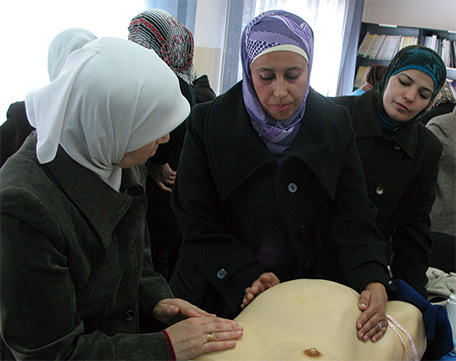
Visiting a Bedouin (nomad) home to conduct educational activities. (Photo: JICA)
●Assistance for the persons with disabilities
As stated in the ODA Charter, Japan pays due attention to the socially vulnerable including the persons with disabilities when drafting and implementing ODA policies. Policies for the persons with disabilities covers a number of different fields, including welfare, health and medical care, education, and employment. Japan has utilized the techniques and experiences Japan has accumulated in these fields through ODA and NGO activities to promote measures for the persons with disabilities in developing countries. For example, Japan has been providing suitable assistances to various local needs, such as promoting barrier-free transportation including railroads and airports, building vocational training and rehabilitation facilities for the persons with disabilities, and providing minibuses for their transportation.
Additionally, through JICA, Japan has conducted wide-scale technical cooperation efforts to build capacity for organizations and personnel offering assistance to the persons with disabilities in developing countries. Included among these efforts are the acceptance of trainees from developing countries and the dispatch of JOCV and a variety of specialists, including physical and occupational therapists and social workers.
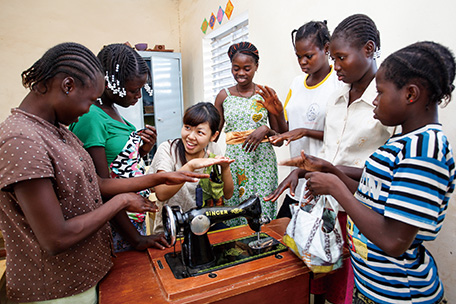
JOCV teaches sewing techniques to deaf women in Burkina Faso as they communicate in sign language (Photo: Akio Iizuka/JICA)

A handover ceremony is held in front of a wheelchair accessible vehicle in Serbia (Photo: Yoko Katakura/Embassy of Japan in Serbia)
●Colombia
Strengthening the Integral Rehabilitation System for Persons with Disabilities, Especially for Victims of Landmines
Technical Cooperation Project (August 2008 - August 2012)
In Colombia, internal conflicts between government forces and illegally armed guerrillas over a period of 40 years have led to a number of landmines being laid and consequently, a great number of civilians were injured by landmines. Because a lot of damage occurs in the rural areas of poverty-stricken regions, victims have poor access to medical facilities and face increased damage due to infection. Additionally, the quality of comprehensive rehabilitation at hospitals in Colombia is undeniably poor.
In addition to providing assistance aimed at capacity building for rehabilitation specialists at four medical facilities in the hard-hit departments of Antioquia and Valle, efforts have been made to improve the first aid treatment received prior to medical examinations at medical facilities in order to help prevent the spread of infection immediately after landmine disasters and encourage social participation among the disabled. As a result of these efforts, there have been qualitative improvements of the integrated rehabilitation system, such as emergency measures, relief routes, treatment at medical facilities, and the rehabilitation until the patient's return to his/her social life. It is now possible to make the rehabilitation and social participation rights of persons with disabilities more widely known, meaning not only improvements in awareness among the disabled but also large-scale community-wide changes in disability awareness.

Japanese expert observes rehabilitation training at a university hospital. (Photo: JICA)
